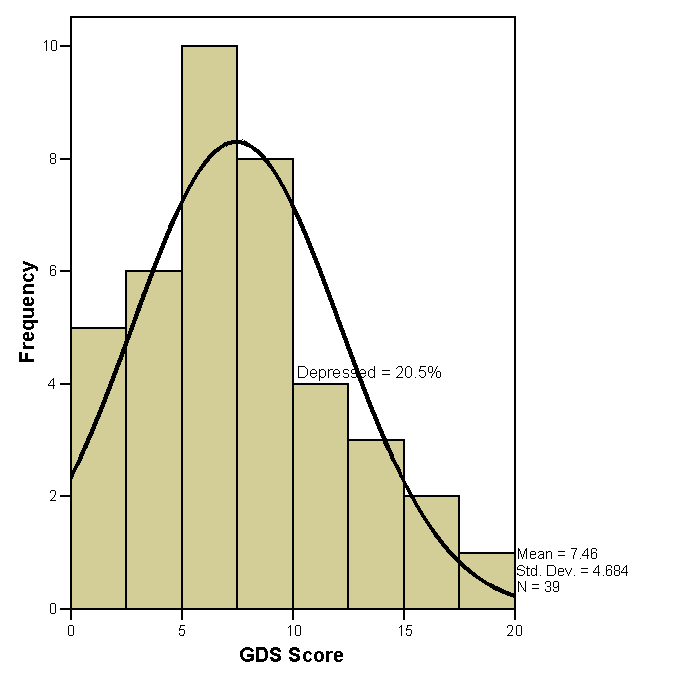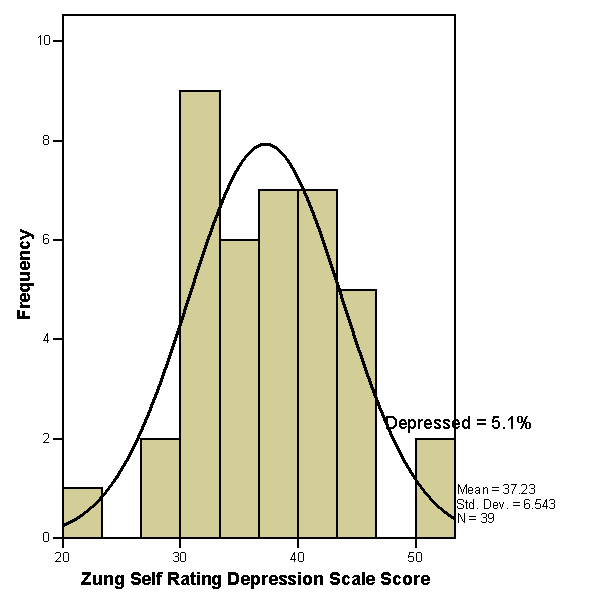The Effects of Environment on Depressive Mood Level in Older Adults
John S. Burnett, Justin L. Trupp, James D. Jackson*
Kutztown University of Pennsylvania
Abstract
The ideal is that individuals should have profound feelings of hope, comfort, and belonging as they approach the end of their life spans. As the average life span increases, so does the amount of care required. A study by Grayson, Lubin, and Whitlock (1995) found significantly higher mood scores for assisted living residents than community-dwelling residents. Results from this study found no significant difference across environments between community dwelling older adults and older adults residing in an assisted living care facility.
Introduction
There are certain elements in one’s environment that can foster or detract from feelings of depression. This study was designed to examine the differences in depression levels in older adults across two different environments, assisted living and community environments. Previous research displayed significant differences between nursing home residents and community residents on the variables of depression, hopelessness, and suicide ideation (Ron, 2004). A study by Grayson, Lubin, and Whitlock (1995) found significantly higher mood scores for assisted living residents than community-dwelling residents. This led them to rank order the mood levels of residents from being least depressed to most depressed, with older adults from the community being first, assisted living being second, and older adults residing in nursing homes being last.
Elderly persons that reside in long-term care settings have been shown to be more vulnerable to experiencing learned helplessness and depression than the elderly in acute or rehabilitation settings (Barder, Slimmer, & LeSage, 1994). Older adults are also harder to treat than younger adults, as the tendency to treat a depressed older adult with anti-depressant medications can lead to an increased vulnerability to side effects. This may be due to older adults being more sensitive to the drugs than younger individuals (Dhooper, Green, Huff, & Austin-Murphy, 1993). Even though depression is a common occurrence in the elderly population, it often goes untreated and undetected (Katona & Shankar, 2004). Bondevik and Skogstad (1996) found that residents in the community and residents in institutions that had infrequent contact with family and friends reported higher levels of loneliness. This study was designed to replicate the results from previous research looking at differences in depression across different environments using both the Geriatric Depression Scale and the Zung Self-Rating Depression scale. The researchers in this study expected to see the same significant difference between environments.
Method
Participants
Older adults (n=40) from the ages of 59-100(M =77.4), were solicited from an assisted living facility (n=16) and residential dwellings (n=24) in Northeastern Pennsylvania. Participants in this study were given three measures, the Mini Mental State Exam, the Geriatric Depression Scale, and the Zung Self-Rating Depression Scale. See examples of each measure in Appendices A and B.
Procedure
Students from Kutztown University administered the scales, in a private one-on-one setting. Subjects must have first passed the Mini-Mental State Exam (MMSE), a screening tool for dementia, to then begin the Geriatric Depression Scale and the Zung Self-Rating Depression scale. See examples of both in the attached appendices. There was one subject that did not pass the MMSE and was not tested. The survey took, on average, 45 minutes to complete. In an open-ended question at the end of the survey, subjects were free to discuss elements of their lives with the proctor. This research received IRB approval from Kutztown University, and all subjects were tested under the ethical guidelines set by the APA.
Results
A t-test assuming unequal variance was conducted on the data. Analysis of the data gathered by this study indicated no significant difference between depression levels in the assisted living care facility and the elderly residing in the community, for both the Geriatric Depression Scale (Community GDS M = 7.58, SD = 6.51), (Assisted Living GDS M = 7.26, SD = 3.30), t(29) = .23, p = .411, and the Zung Self-Rating Depression Scale (Community Zung M = 37.17, SD = 6.51), (Assisted Living Zung M = 37.3, SD = 6.83), t(29) = -.075, p = .470. Scores from both the Geriatric Depression Scale and the Zung Self-Rating Depression scale showed a large amount of variation.
Table 1
Table 2
Conclusion
According to previous research on the subject of depression between different environments of older adults, there should have been a difference between environments. The researchers found no such difference, but also found a significant amount of variation among the older adults solicited for this study. There could be several reasons for this difference. One of the contributing factors of the variation could be due to the help-seeking behaviors and attitudes toward depression of older adults. That is, older adults may vary on the amount of help they will seek out for depression. Several older adults entering the testing room made comments like, “I’m not depressed.”
The Geriatric Depression Scale and the Zung Self Rating Depression scale both showed a large amount of variation. Previous studies comparing older adults have had larger amounts of power. For example, Barder, Slimmer, and LeSage (1994) had well over a hundred older adult subjects. Perhaps more participants are needed to better examine the differences in depression across environments in which older adults reside.
Appendix A
Zung Self Rating Depression Scale
1. I feel down hearted, blue and sad.
- None or a little of the time
- Some of the time
- A Good part of the time
- Most or all of the time
2. Morning is when I feel the best.
- None or a little of the time
- Some of the time
- A Good part of the time
- Most or all of the time
3. I have crying spells or feel like it.
- None or a little of the time
- Some of the time
- A Good part of the time
- Most or all of the time
4. I have trouble sleeping through the night.
- None or a little of the time
- Some of the time
- A Good part of the time
- Most or all of the time
5. I eat as much as I used to.
- None or a little of the time
- Some of the time
- A Good part of the time
- Most or all of the time
Appendix B
Geriatric Depression Scale
21. Are you basically satisfied with your life?
A. Yes
B. No22. Have you dropped many of your activities and interests?
A. Yes
B. No23. Do you feel that your life is empty?
A. Yes
B. No24. Do you often get bored?
A. Yes
B. No25. Are you hopeful about the future?
A. Yes
B. No26. Are you bothered by thoughts you can't get out of your head?
A. Yes
B. No27. Are you in good spirits most of the time?
A. Yes
B. No28. Are you afraid that something bad is going to happen to you?
A. Yes
B. No29. Do you feel happy most of the time?
A. Yes
B. No30. Do you often feel helpless?
A. Yes
B. No31. Do you often get restless and fidgety?
A. Yes
B. No
References
Barder, L., Slimmer, L., & LeSage, J. (1994). Depression and issues of control among elderly people in health care settings. Journal of Advanced Nursing, 20(4), 597-604.
Bondevik, M., & Skogstad, A. (1996). Loneliness among the oldest old, a comparison between residents living in nursing homes and.. International Journal of Aging & Human Development, 43(3), 181.
Dhooper, S. S., Green, S. M., Huff, M. B., & Austin-Murphy, J. (1993). Efficacy of a group approach to reducing depression in nursing home elderly residents. Journal of Gerontological Social Work, 20(3/4), 87-100.
Grayson, P., Lubin, B., & Van Whitlock, R. (1995). Comparison of depression in the community-dwelling and assisted-living elderly. Journal of Clinical Psychology, 51(1), 18-21.
Katona, C. L. E., & Shankar, K. K. (2004). Depression in old age. Reviews in Clinical Gerontology, 14(4), 283-306.
Ron, P. (2004). Depression, hopelessness, and suicidal ideation among the elderly: A comparison between men and women living in nursing homes and in the community. Journal of Gerontological Social Work, 43(2), 97-116.
|

